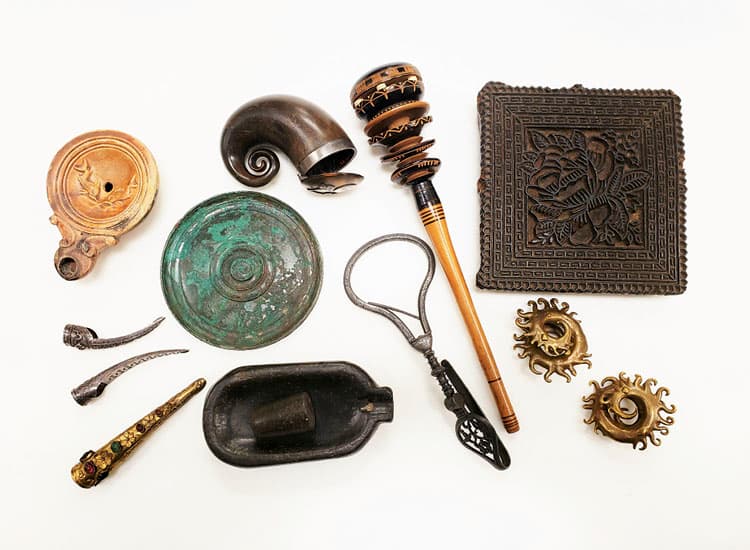Education Art Collection
- Magazine Article
- Collection
- Education
New programming for novel experiences

“Calling All Gumshoes! What in the World?” is an Art to Go unit of mysteries for participants to solve. It includes objects, such as a Mexican Chocolate Beater (1900s) and an Egyptian Mortar and Pestle (BC 1900–1600s), that are not immediately recognizable. Through close looking, critical thinking, and group discussion, students can develop hypotheses about the objects’ purposes and origins and provide observational details to justify their ideas.
Educational programs at the CMA are designed to spark wonder. Whether on a field trip or in a virtual lesson, we let our learners’ curiosity guide the way. Our exceptional education art collection (EAC) is a powerful resource in this effort, as it allows for a more intimate, multisensory experience with art. Unlike objects in the main collection, these items offer learners tactile experiences with original works of art. This teaching collection spans 5,000 years of global human history and includes around 10,000 authentic objects that can be handled by the public both inside and outside the museum.
Founded two years before the CMA opened its doors in 1916, the EAC was initially known as the extensions collection. It “extended” the reach of the museum through mini-exhibitions installed in display cases within schools, libraries, and community centers. It was an ambassador of sorts that offered a glimpse of what the museum had to offer.
As they built the collection, the museum’s education staff established accession criteria that reflected the educational goals of the time. Its primary audience was children. That is perhaps why there are so many animals, bright colors, and images with clear narrative content in the collection. They also acquired specimens from global cultures or ancient peoples for their instructional potential. To inspire art students, museum educators collected objects exemplifying good design or artistic processes. Ease of transport, replaceability (in case of breakage), and size were also considerations. Today, the EAC’s areas of strength include ceramics, armor, textiles, works on paper, and decorative arts from the Americas, Africa, Asia, and Europe.
After a successful 80-year run and more than 32,000 mini-exhibitions, the extensions program was discontinued in 1992. Today, EAC objects are used in programs like Art to Go, in which docents and museum staff bring authentic artworks—now packaged in themed “suitcases”—into the community. Visitors to the museum may come across pop-up Art Cart stations designed to offer the general public novel experiences. During both programs, participants can touch and closely examine EAC objects while asking questions and engaging in conversation with a docent or museum staff.
As the field of museum education evolves, CMA staff members have reflected on the role of the EAC within school programs. While we value sharing facts about works of art, we prioritize modeling the many possibilities for how to engage with and learn through art. We’ve identified the broad goals of cultivating “learners” over “knowers” and introducing opportunities for students to practice five capacities in any combination: attention, connection, creativity, perspective, and wonder. How might the EAC best support these goals and classroom-based learning? What is the value of being able to handle works of art?
Intuition and experience suggest that museum encounters that incorporate the ability to touch objects might enhance students’ attention, help them make connections, and spark their curiosity. Recent research supports this hypothesis. A landmark 2018 study conducted by the National Art Education Association and the Association of Art Museum Directors found that students who experienced a facilitated single-visit program in an art museum benefited in four interrelated ways: they asked more complex questions, were more open to multiple interpretations, appreciated the physicality of art, and had more vivid emotive recall of the learning experience.
We’ve seen ongoing evidence of these markers regularly in EAC programs. Kindergarteners studying armor came to the CMA for a guided visit of the Jack, Joseph and Morton Mandel Armor Court, then eagerly touched and carefully examined a 16th-century steel helmet, breastplate, and other pieces of armor in a museum classroom. Students were awestruck by touching a 4,000-year-old Egyptian canopic jar lid, and one high schooler shared how honored they felt to be trusted with the responsibility of handling valuable artifacts.
EAC programming prompts lively conversations about the purpose of objects and their connections to our own lives and experiences and invites students to practice sustained, multisensory attention with one object at a time. How do we bring this intimate experience to more students?
One solution we tested was adapting Art Cart for our school groups. Modeled after the public Art Cart pop-ups, this format invites tour groups to opt into a 15-minute Art Cart stop as part of their visit. In this version, which will now be offered regularly during fall 2022, classes are broken down into smaller groups of four to six students, each directed to a station with objects and a facilitator. The experience is designed to reach a maximum number of students while still offering the wonder of an authentic hands-on, object-based experience and student-driven discussion with Art Cart facilitators.
Through EAC programs, tours in the galleries, and virtual lessons, students engage their senses, make connections across time and place, get curious, and wonder about the world. The CMA’s education staff, the EAC, the museum’s galleries, and the world-class artworks are the distinctive teaching resources that help us serve rich and unique learning experiences to students of all ages.
For more information about the museum’s education art collection and school programs, visit cma.org/learn.